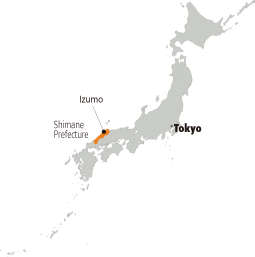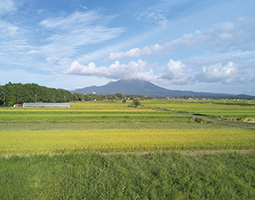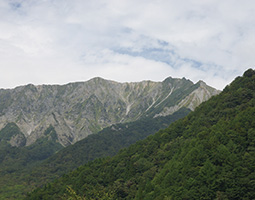Home > Highlighting JAPAN > Highlighting Japan October 2017 > National Parks
Highlighting JAPAN
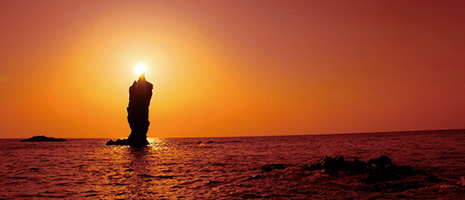
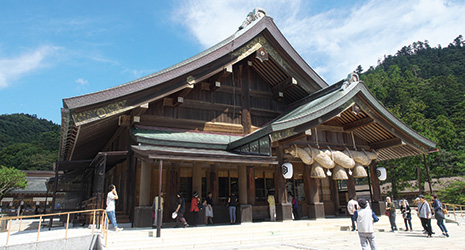
- PREVIOUS
- NEXT
Daisen-Oki: A Legendary Land
Extending over the prefectures of Tottori, Shimane and Okayama, Daisen-Oki National Park is home to the Shinto legends of Izumo and a wealth of stunning natural scenery.
Daisen-Oki National Park boasts a hugely varied landscape, including a mountainous area from Mt. Daisen to Hiruzen Highland, the coastal area of the Shimane Peninsula, as well as Mt. Sanbe and the Oki Islands.
The mountainous area is made up of various topographical elements, such as spectacular volcanic terrain, rich forests and vast grass-covered plains. There are locations that provide distinctive mountain views, and visitors can see a wide variety of plants and animals that have adapted to these environments. For example, the Oki Islands boast Japan’s largest seaweed bed and the wind-swept shrub zone of Daisen Japanese yew trees.
The coast and islands are distinguished by diverse views of sea and shore formed by a combination of complex factors. Both the Oki Islands and the Shimane Peninsula are the setting for ancient Japanese myths such as the Kunibiki Shinwa (land dragging myth, in which a god gathered mountains and lands by pulling them with a rope to make the land of Izumo bigger). The Shimane Peninsula in particular is the center of ancient Izumo culture, and is dotted with historical sites and famous locations linked to its mythology, such as the Izumo-taisha shrine.
One of the national park’s most popular spots is the Izumo-taisha shrine (officially called the Izumo Oyashiro), which is located in Shimane Prefecture and faces the Sea of Japan. It is said that all the kami gods of the Japanese archipelago gather at the shrine during the lunar calendar month of October each year. Another name for the old lunar calendar month of October is kannazuki, which literally means “the month of no gods”; in other words, the gods have left their usual homes. These gods, worshipped by local people, are the spirits of nature that live in the land, mountains, rivers, forests, trees, rocks and other natural objects. It is said that when they gather at Izumo they consult and decide on marriage partners for the unmarried men and women among those who worship them every day. Due to this legend, Izumo-taisha is famous as a “marriage shrine” and many people from all over Japan come to worship.
Izumo-taisha has a long history second only to Ise-jingu. However, there are several theories regarding the establishment of the shrine. The current proportions of the shrine are said to date from a 1248 refurbishment, and its current main hall to have been reconstructed in 1744. Meanwhile, a modern symbol of the Izumo-taisha is a huge Shinto shimenawa rope that has decorated the kagura hall since it was rebuilt in 1981. At 13 meters in length and weighing 4.5 tons, this shimenawa is among the very largest from all of Japan’s 81,000 shrines. Every several years, this giant shimenawa is made and replaced by staff from the Ohshimenawa Sousakukan in Iinan Town, Shimane Prefecture. The next planned replacement (the seventh) will be in July 2018.
Another of the Daisen-Oki National Park’s most popular spots is Mt. Daisen, a 1,729-meter-high stratovolcano located in Tottori Prefecture. Mt. Daisen is the highest peak in the Chugoku region of Japan, and looks quite different depending from where it is viewed. From the expanse of agricultural land to the west it shows an elegant and feminine aspect, but from the north and south the mountain takes on a very different wild and masculine form. In particular, there is a superb view of Mt. Daisen’s south face from the 800-meter-high Kagikake-toge Pass. The ferociously steep white face of the mountain rises above verdant fields in spring, and a carpet of colored leaves in autumn. It is stunningly beautiful.
Mt. Daisen has been worshipped as a sacred mountain of the gods since ancient times, and has historical sites, shrines and temples. Nor is Mt. Daisen only attractive to look at. There are outdoor activities such as viewing spring greenery, summer hiking, viewing autumn leaves, and skiing in winter.
Meanwhile, two other spots rival the Izumo-taisha and Mt. Daisen in popularity. One is Cape Hinomisaki, which is located at the western tip of the Shimane Peninsula and is closely connected to the Shinto religion of Izumo. The other is Lake Shinji, a brackish-water lake that continues out from the national park and extends across Izumo City and Matsue City in Shimane Prefecture. The area around Cape Hinosaki features a raised beach with complex topography and many visitors are entranced by the Hinosaki Lighthouse that stands on these impressive cliffs.
A little over an hour’s journey away by high-speed ferry is Okinoshima Island (one of the Oki Islands) with an undulating coastline created over the ages that offers a variety of views. One particularly popular spot is an unusually shaped tall and slender vertical rock formation that protrudes from the sea by the island’s northwest shore. When the sun sets behind the rock’s peak, it resembles the flame of a candle, giving the rock its name of Rosoku-jima island (Candle Island).
Visitors can fly from Haneda Airport to either Yonago Kitaro Airport or Izumo Enmusubi Airport, then change to a train or bus to travel through the countryside — a pleasure in itself — to the cities of Izumo or Matsue, either of which make a good base for a trip to the Daisen-Oki National Park.
- PREVIOUS
- NEXT
© 2009 Cabinet Office, Government of Japan
